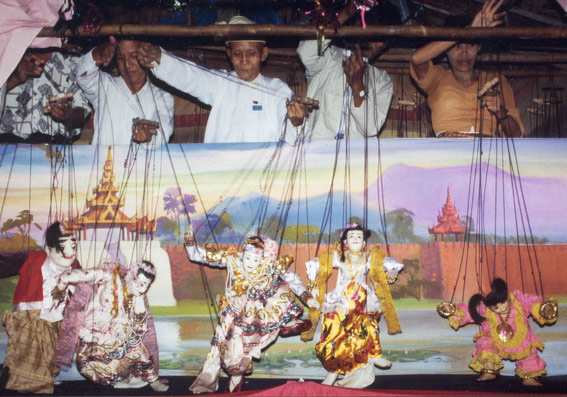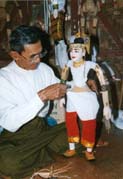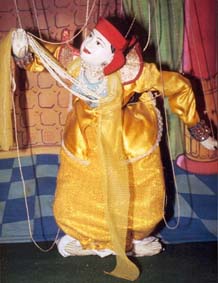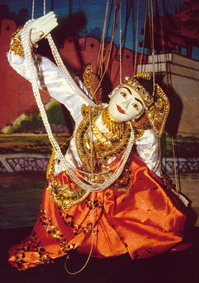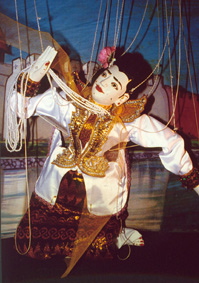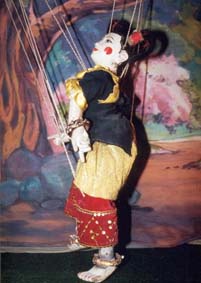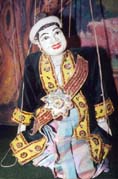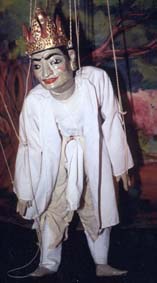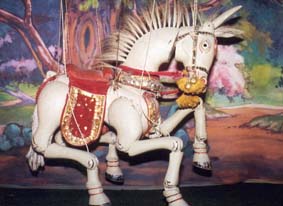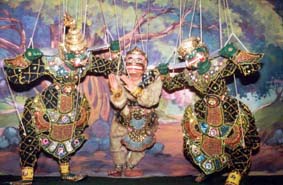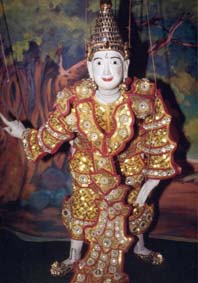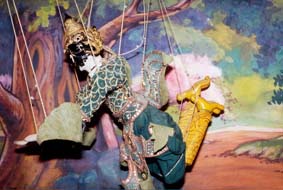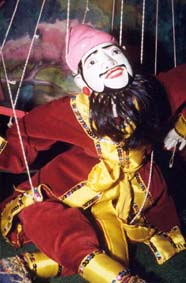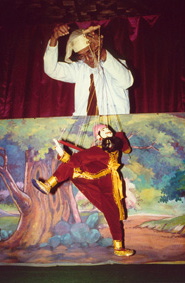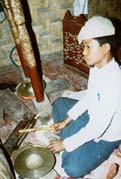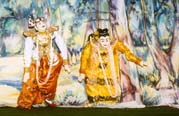AH MYINT THABIN, TRADITIONAL PUPPETRY OF MYANMAR (BURMA)by Elisabeth den Otter
Introduction
Burma (now Myanmar) is situated in Southeast Asia, between China and India. It is inhabited by ethnic groups like the Burmese, Mon, Shan, Karen, and others; the majority is Buddhist, but there is also a strong belief in 'nats', the animist spirits of the land.
Traditional Burmese puppet theatre (yoke thay) dates from the 15th century. In the 19th century it reached the peak of its popularity, but after that other types of -lighter- entertainment became more popular.
The name 'ah myint thabin' (high performance) refers to the fact that the puppets perform on a raised platform, contrary to human dancers who perform on ground level (ah naint thabin). The puppeteers stand on a platform behind a handrail; their lower bodies are hidden by a painted backdrop in front of which the puppets perform, and their upper bodies are hidden by a curtain. When not in use, the puppets hang behind them. The performances usually last all night.
A company consists of puppeteers, singers and musicians. Singers sit next to the puppet players and sing or declaim the texts of the more complicated characters, like the Prince and the Princess. They have to be able to sing in different styles, deliver the dialogues smoothly and draw on a broad knowledge of poetry and literature.
A puppet show begins with the appearance of Thagyar Min, the King of the Spirits (Nats), and the Medium (Natkadaw) who pays tribute to the Buddha and the nats. Then a number of characters come on stage representing the Creation of the World (Himavunta): the White Horse, the Monkey and the two Ogres, Zawgyi the magician, and Garuda, the mythical sun eagle who fights with Naga, the mythical snake. After the chaos of the Creation, order is represented by the Foundation of the Kingdom, with characters like the king and his wife, the prince and the princess, the ministers, the royal astrologer, pages and clowns. In every Burmese drama, a compulsory scene is the dance duet. The prince dances beautifully, to impress his love. The duet is the finale of the puppet show, and the favorite item of the public.
The puppets
A set consists of at least 28 puppets. There are pieces of scenery on the stage, such as a throne. Painted backdrops represent the scene of the action: a forest or a palace. Each puppet has its own particular way of dancing, with accompanying music and song. (It is said that live dancers have copied their movements from the puppets.)
The wood has to be resistant, easy to carve and light. The type 'Gmelina arborea' (yamanay) is often used. Most puppets have eleven strings. Five of these strings attach the head, the shoulders and the rump to the H-shaped wooden cross piece. The upper arms, thighs and hands are operated with the six remaining strings which hang loose and are draped over the cross piece.
The anatomical aspects of the puppets have been studied by Dr Tin Maung Kyi, a medical doctor from Mandalay and expert on Burmese puppetry. He discusses the construction, measurements, and movements of the puppets in -unpublished- papers that are illustrated with excellent drawings. He has carved a number of beautiful puppets as well. Generally, a puppet is made up of 17 to 19 pieces: the head and neck piece, the body in 2 pieces, a pair of arms in 6 pieces and a pair of legs in 8 pieces. They are joined together by means of strings. The height of a puppet is determined by its head, and the head circumference by a hand-span (a measure between thumb and tip of the middle finger, which is roughly equivalent to 9 inches). The formula is: a hand span plus 4 fingers' breadth is the circumference of the head; the head length from top to chin is the standard unit; seven and a half times of this is the height of the puppet from top to toe; and half of the height is the arm length from the shoulder to the tip of the middle finger. Nowadays, the puppets measure between 45-70 cm. An interesting detail is that the sexual organs are carved as well, even though they cannot be seen.
The head, hands and feet of the puppets representing humans are carved and painted, after which the body parts are tied together. Then the strings are attached to the cross piece. Finally, the puppet is dressed in the clothes and given the attributes that correspond to its character. Souvenir puppets, smaller in size, are sold in temple shops and markets, and much appreciated by tourists.
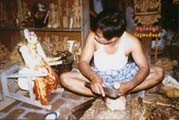
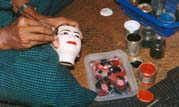
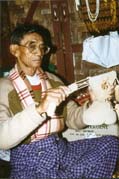
The characters can be humans, animals, or mythical beings.
Humans
The Hermit (Yathay) is the patron of the puppetry, a holy man endowed with powers to bring comfort and good fortune. He wears a simple brown robe and a flat-topped hat. This puppet is treated with the greatest respect by puppeteers, and often stands near the shrine of the Buddha in their home.
The Medium (Natkadaw) is often dressed in red, the favorite color of nats; her hair flows down, and a band of red silk circles her brow, two short ends fluttering over the ears. A long silk scarf is tied around her torso, knotted on her bosom. The medium-puppet is the first to appear on stage, and her choreography is based on the movements of a real-life medium, the sway and tremble of a 'possessed' person. She lifts the homage-offerings bowl towards heaven, supplicating the nats, and towards the audience. The Natkadaw dances for the nats and offers them a coconut and bananas.
The Prince (Mintha) is the leading character of most classical plays, together with the Princess. He is gorgeously dressed; he wears a pair of half-length trousers underneath his sarong, so that he can perform acrobatic feats. Around his head he wears a head wrap (gaung baung). His -human- hair is done in a neat top-knot. In tragic scenes, the hair is let loose, to depict sorrow so deep that the sufferer has no desire to comb his hair.
The Princess (Minthamee) is the romantic heroine. Her hair is done in a top-knot, with a fluffy tress hanging loose on the right side, flowers cascading along its length. The princess embodies the Burmese ideal beauty, so her face is always beautifully sculpted and painted. Her jacket is the most opulent, heavily embroidered, and she wears a lot of jewellery.
The Page (Thungedaw) makes sure all is in good order for the arrival of the king and his entourage. Page boys were young sons of lesser princes and nobles who served as errand boys in the palace. The small puppet skips around, forefingers outstretched, as he points out things that need to be done. He is dressed rather like a jester, but with gold medallions and chains around his neck. He wears his hair tied in two bunches, one on either side of the head, high above the ears. The design on his cheeks is made with 'thaneka', cream made of the bark of a tree, to protect the skin from the sun.The King (Min) usually does not wear his ceremonial costume, which is 'reserved' for the King of the Celestial Beings. His clothes are simple: a white jacket, a sarong, and a white tubular circlet as a head dress. He wears leather shoes incrusted with semi-precious stones and decorated with a bird (hin tha). 24 Strands of gold crisscross his chest, and he carries a golden dagger in his right hand. The Queen is dressed like a wealthy lady.
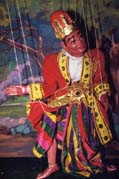
The 4 Ministers (Wun) are the narrators of the plot, and discuss current affairs as well; they are not dancing puppets. The Home Minister is dressed in a long deep red robe, edged with gold, and wears a high velvet red hat, banded with gold and jewels. Under his robe, open at the front, he wears a silk jacket and a sarong. The Minister of the Secretariat wears a robe similar to that of the Prime Minister, but of a different color. He wears a white tubular circlet on his head, with two narrow rabbit-ears at the back.
The Royal Astrologer (Ponna), dressed in simple white garments, is a Brahman; they are famed as astrologers, interpreters of dreams, and masters of ceremony for auspicious occasions. In drama, they are the much needed villains. (In modern times, the Brahman is replaced by a comic figure, who is groom to a horse or elephant.)
The two Jesters (Thancho and Thanpyet) are dressed identically in checked sarongs tucked up and short jackets open at the front, with large gold anklets and bracelets. They wear charms around their necks, which are made of sacred threads woven thick, with a silver amulet wrapped across the middle. These are not dancing roles; they are companions to the Prince. The jesters have sharp wit and dexterity with puns, criticize people and comment on actual events.
Ethnic groups, like the Shan and the Karen, are also represented through puppetry. For example, two Shan men dressed in black perform a sword dance, and two Karen women perform a dance with handkerchiefs.
Animals
The White Horse (Myin) plays an important role in Burmese mythology and the traditional 'Himavunta' (Himalayan) scene in a Burmese puppet show. It is the symbol of the horse-head shaped constellation which was supposed to have appeared at the birth of the universe. The horse dance represents the creation of the earth. The horse puppet is always a white stallion. Tiny silver bells are attached to the halter and trappings which are woven out of bright colored yarn, gay with pom-poms. The White Horse, the first living being on earth, descends to earth, dances around for a while, and goes back to heaven.
The Monkey (Myauk) romps around the stage. His head is in the stylized form of Hanuman, the monkey-god of the Ramayana epic; he usually wears a few human garments over his furry velvet body. The ogres kick him around a bit and chase him away.
Mythical beings
The King of the Celestial Beings (Thagyar Min). His costume is opulent, the 7-tiered head dress studded with brilliants, and his gold colored robe stiff with sequins and beads. He carries a double-edged sword in his right hand. This costume is a replica of the ceremonial dress worn by the Burmese kings on state occasions. This puppet always descends upon the stage from above the handrail, signifying his abode on high; his feet must never touch the floor.
Ogres (Belu's) wear beautiful green costumes. They carry short swords, one of the five items of the Burmese king's regalia. There are two ogres, the City Ogre (Nan Belu) and the Jungle Ogre (Taw Belu). The city ogre's head dress is topped with a jewelled spike, the jungle ogre's with a plumed crest. Their dance is mostly a show of evil power and strength, and the ominous music, combined with stalking steps, creates a most chilling mood. After chasing the Monkey away, they chase each other and engage in hand-to-hand combat. The city ogre always wins, and he exits chasing the jungle ogre.
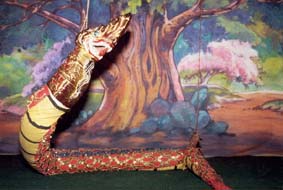
The mythical Snake (Naga) is the mortal enemy of the mythical Sun eagle (Garuda), who chases him around the stage. The latter has a bird's head, human body and hands, with wings attached and talons.
The Magician (Zawgyi) roams through forests and over mountains, capering and singing as he goes, in search of medicinal plants and the fruits of the wishing tree, which he magically transforms into beautiful girls. On his wanderings he sings about the beauty of nature, as he searches constantly for the philosopher's stone. One touch of his magic wand and the stone will change everything into gold. He is dressed in red, wearing a long and flaring robe trimmed with gold, a red cap on his head, red slippers and trousers under a tucked-up sarong. With a red staff he grinds medicine, or prods at certain fruits to turn them into nymphs of pleasure. He can fly through air and bore through earth. This puppet has the least number of strings, but his dance steps and acrobatic leaps are fast and complicated. His joints are specially made to allow for the agility of this character. He enters and exits from above the handrail. Any puppeteer who handles this puppet well is regarded as a master of the art.
The musicThe orchestra (hsaing-waing) accentuates the dramatic moments of the performance. The musicians open the performance with a sort of overture. By beating the suspended knobbed gong (maung), clashing the cymbals, and beating a fast drum rhythm, a musical interpretation is given of the repeated destruction and recreation of the earth by the elements fire, wind and water.

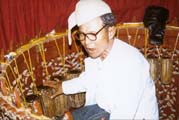
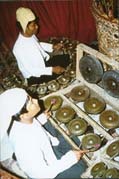
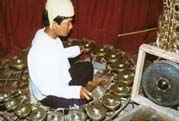
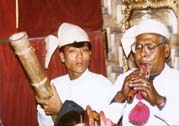
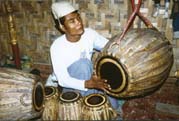
A set of twenty-one tuned drums (pat-waing) in a circular frame is the leading instrument. The drums are beaten with the hands and hung vertically within the frame so that the musician plays on the upper heads only. Two sets of gongs, struck with beaters, support the pat-waing: a set of 18 small sharp-toned knobbed brass gongs (kyi-waing) set horizontally on a circular wooden frame, and a set of 18 small mellow-toned bronze gongs (maung-zaing) mounted in rows on straight wooden frames which are laid flat on the ground and propped up against the pat-waing. One or two shawms (hnay) also play the melody, weaving a harmony amidst the staccato notes of the drums and the gongs. The percussion is played on a large drum (pat-ma), hung in a frame which represents a mythical animal, and a set of tuned drums (pat-ma-gyaung), played with the hands. The drums are tuned by the amount of tuning paste in the centre of the skin surface: a mixture of ash and cooked rice, kneaded smooth. Cymbals (yagwin), large bamboo clappers (walet hkok) and a small wood block (byauk) complete the percussion instruments.
The melody 'Bé maung' is used for intense scenes, such as the destruction of the world, the fight of the Ogres, and the fight between Naga and Garuda. The Prince and the Princess sing the song 'Taung Taw Tharyar' (Beautiful mountain and forest) during their duet.
The frame of the drum chime and the panels behind which the musicians are sitting is made of vermilion lacquered wood covered by gold leaf, and adorned with traditional designs of flowers and leaves and small pieces of colored glass.
The Jataka's
In the second part of the performance, a jataka is enacted, one of the 547 stories about the past lives of the Buddha. The last 10 jataka's are often used for puppetry. These stories feature kings, princes and princesses, hermits and wise men who undergo all kinds of adventures. A happy end is mandatory: virtue is rewarded and evil is punished. Each jataka symbolises a specific virtue such as honesty, wisdom, love of a son for his parents, etc.
Jataka no.540 tells the story of Suvanna Sama. A hunter's son marries a hunter's daughter, and both become ascetics. The wife becomes pregnant without human intercourse, and bears a son, Suvanna Sama. The parents are both blinded by a snake, and the son attends upon them. A king, coming out to hunt, sees the lad and shoots him with an arrow; but on learning his dutiful affection he repents, and attends upon the parents himself. The boy is miraculously cured and the parents recover their sight.
Jataka no. 519 tells the story of King Brahmatta whose beloved son Sotthisena is afflicted with leprosy. The king decides to send him away. Sambula, Sotthisena's beautiful and virtuous wife, joins him in his exile in the forest, to take care of him. While gathering wild fruit, she meets with an ogre who falls in love with her and tries to seduce her. She is rescued by Thagyar Min, the King of the Spirits, who chases the ogre away. When Sambula returns to the prince, he refuses to believe her story. She is very sad, because she loves him dearly and would never betray him. Finally, when he admits that she speaks the truth, he is cured. The prince and the princess return to the court, where they live happily ever after.
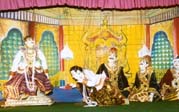

The future
After Independence from the British (1948) traditional puppetry troupes diminished rapidly, even though the military regime (from 1962) expressed an interest in puppet theater, mainly for political purposes. With the opening up of the country, tourism has been an important stimulus of traditional puppetry, which led to a revival of interest on the part of the Burmese people as well.
Luckily, a number of old puppeteers are still active, and passing on their knowledge to a younger generation. Among them: U Pan Aye (Mandalay), U Thun Gyi (Rangoon), and U Maung Hla (Bagan). U Pan Aye ('Baba') is the 'star' of the Mandalay Marionettes Theatre, which was built especially for tourist performances that last approximately one hour. U Maung Hla ('Zawgyi Pyan') performs on a small stage in the courtyard of his home. The younger generation also performs so-called 'dinner shows' in tourist hotels. Mandalay Marionettes Theatre has been performing regularly abroad, with much success. Their performances in Burma have also increased, for instance at the occasion of pagoda festivals.
Even though the competition from movies and television is great, puppet theater is still holding its ground, by adapting itself to modern times. Where kings were the patrons in the past, tourists are the patrons of today.
Literature:
Bruns, A.: Burmesische Marionettenkunst
2000, Bangkok (Ph.D.Thesis)Cowell, E.B.: The Jataka or Stories of the Buddha's former births
1969, London: Luzac & CoMa Thanegi: The illusion of life. Burmese marionnettes
1994, Bangkok: White Orchid PressSinger, N.F.: Burmese puppets
1992, Singapore, Oxford, New York: Oxford University PressCD-Rom:
Otter, den, E.: Thabin. Burmese puppetry, music, song and dance
2000, produced on own account
(contact: edomusic@mac.com)More about puppetry
